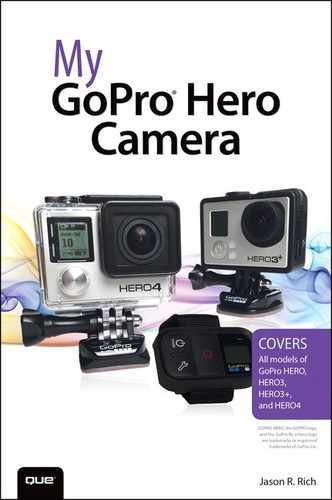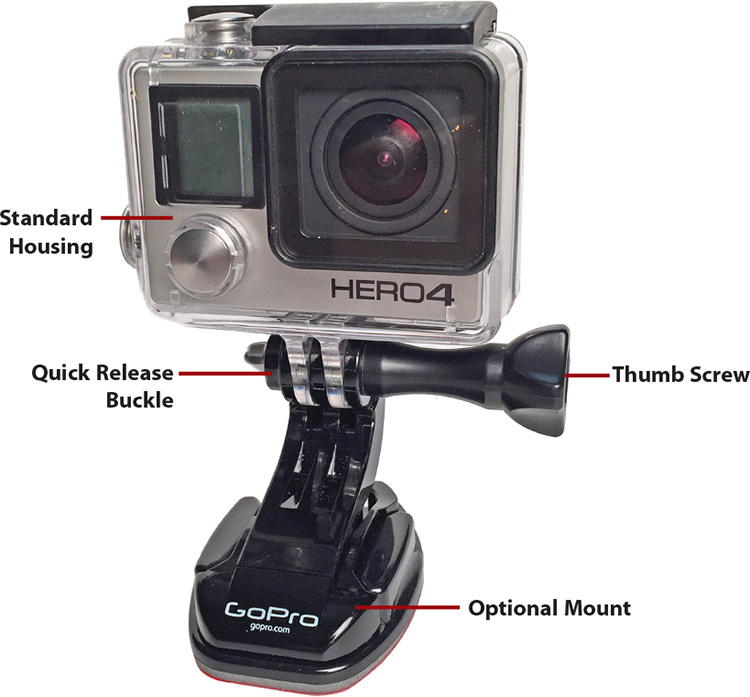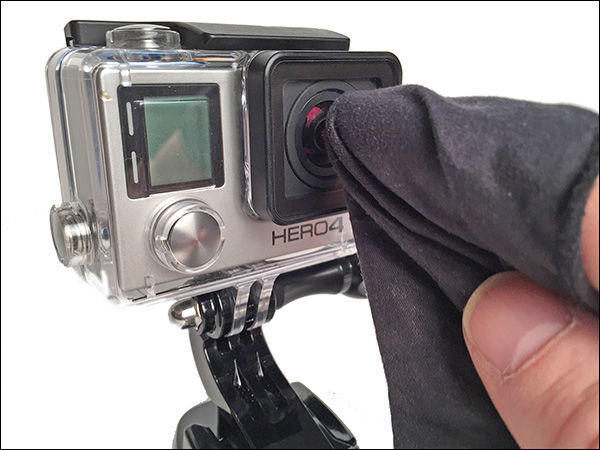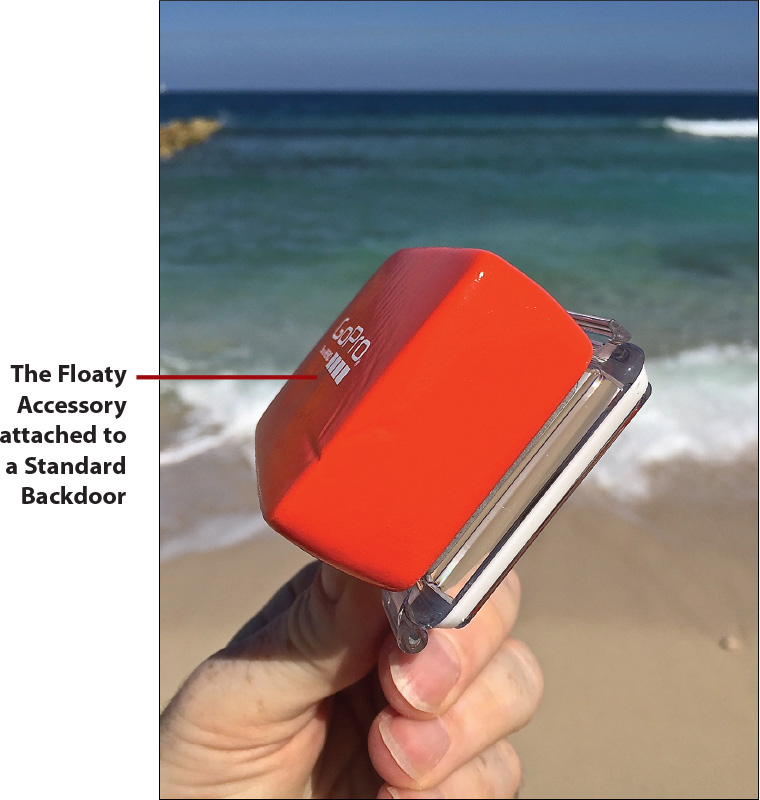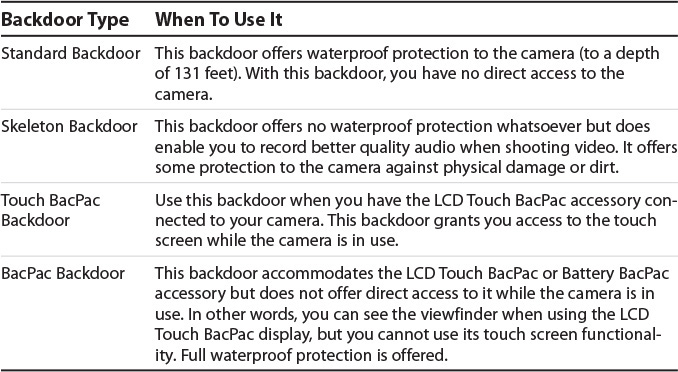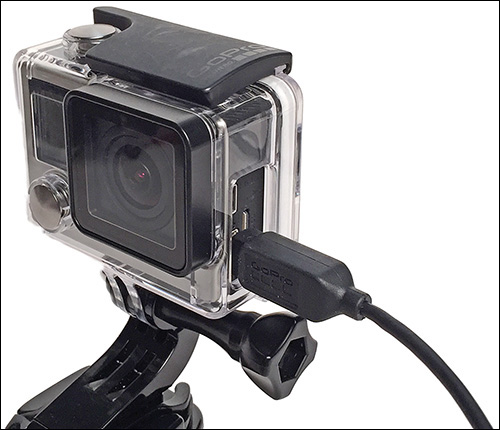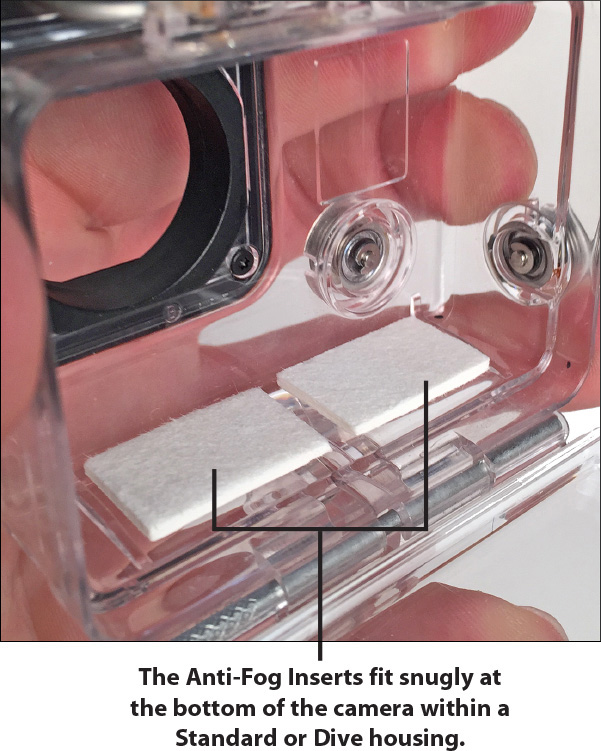3. Overview of GoPro Camera Housings
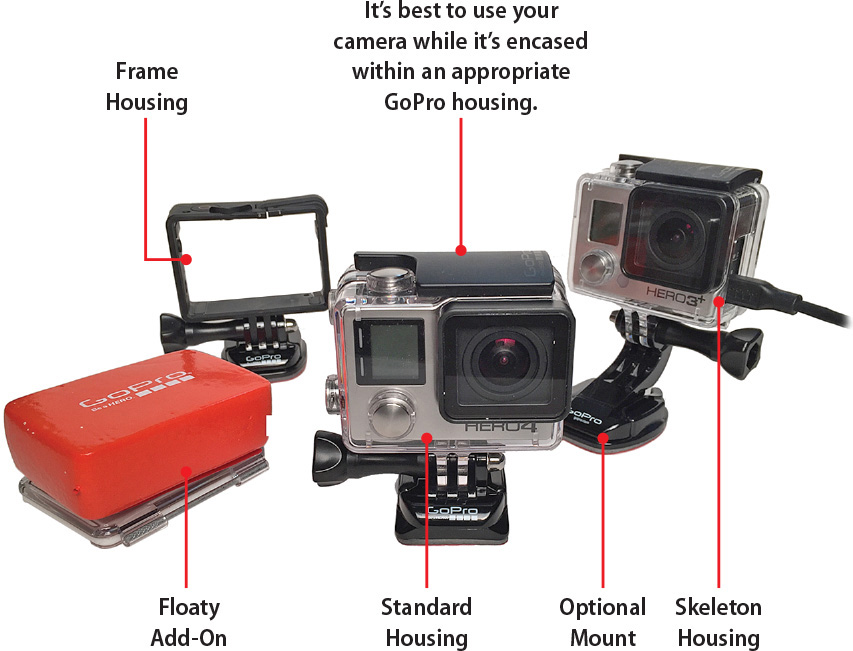
In this chapter, you learn all about the optional housings available for your GoPro camera and discover some of the best uses for them based on your shooting situation. Topics include the following:
![]() How to insert and remove your camera from a housing
How to insert and remove your camera from a housing
![]() An explanation of housing backdoors
An explanation of housing backdoors
![]() An overview of housings available from GoPro, plus strategies on when to best use each housing based on your shooting situation
An overview of housings available from GoPro, plus strategies on when to best use each housing based on your shooting situation
What makes the GoPro cameras so durable are the optional housings available for them—not the camera body itself. Even if you plan to shoot in the calmest, cleanest, and driest conditions, you should still use a housing with your camera to protect it from damage, water, and dirt.
A single speck of dust or a fingerprint on the camera’s lens can ruin all your shots until the lens is cleaned. Meanwhile, if the camera body is exposed to even a small amount of water, serious damage can easily occur.
The good news is that GoPro offers optional camera housings designed for specialized uses. Most of the time, the Standard Housing (which makes the camera waterproof down to 131 feet with the appropriate backdoor) provides the necessary protection and versatility needed in a wide range of shooting situations. However, with this Standard Housing, you have several backdoor-related options.
Available from GoPro’s website (as well as GoPro authorized dealers) are several other housings (sold separately), including the Blackout Housing, Skeleton Housing, Dive Housing, the Frame Housing, and the Duel Hero System Housing. You will also discover additional housing options are offered by third parties.
Most GoPro Housings Use a Quick Release Buckle
In addition to providing protection, the bottom of each housing features GoPro’s proprietary Quick Release Buckle and detachable Thumb Screw, which enable the camera (within its housing) to be securely attached to any specially designed mount or related accessory. More information about mounts can be found in Chapter 4, “Overview of GoPro Camera Mounts.”
You need to choose the most appropriate housing for your intended shooting situation. Then, as you’re shooting with the camera, it’s your responsibility as the photographer or videographer to keep the housing clean, particularly the area in front of the lens.
Inserting and Removing Your Camera from a Housing
The majority of the optional housings for the GoPro cameras are made from durable and clear plastic. The front of the housing connects to the backdoor via a hinge, and the top of the housing features a latch. Between the front and backdoor of most housings is a watertight rubber seal.
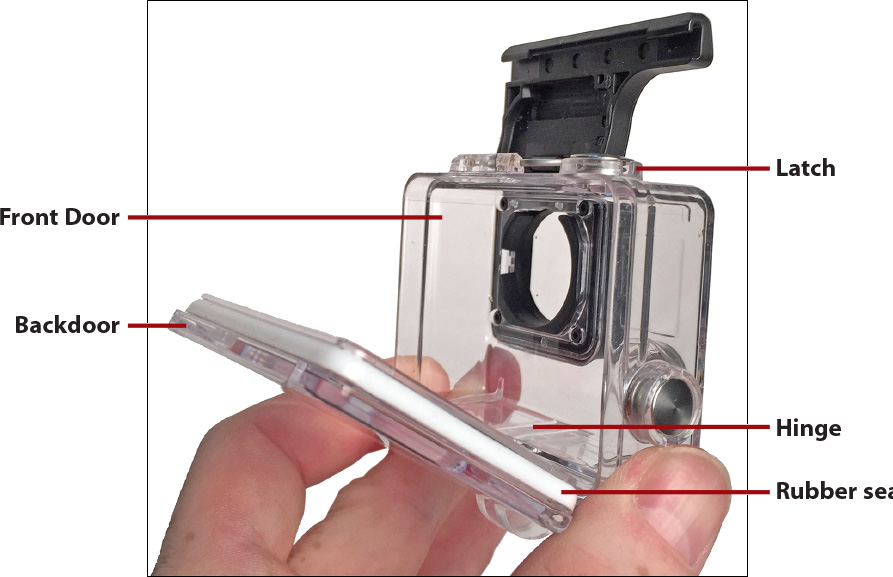
Because the majority of the housings are designed to completely encase the camera, these housings offer external buttons that correspond directly to the buttons built in to the camera. Thus, you still have manual access to them.
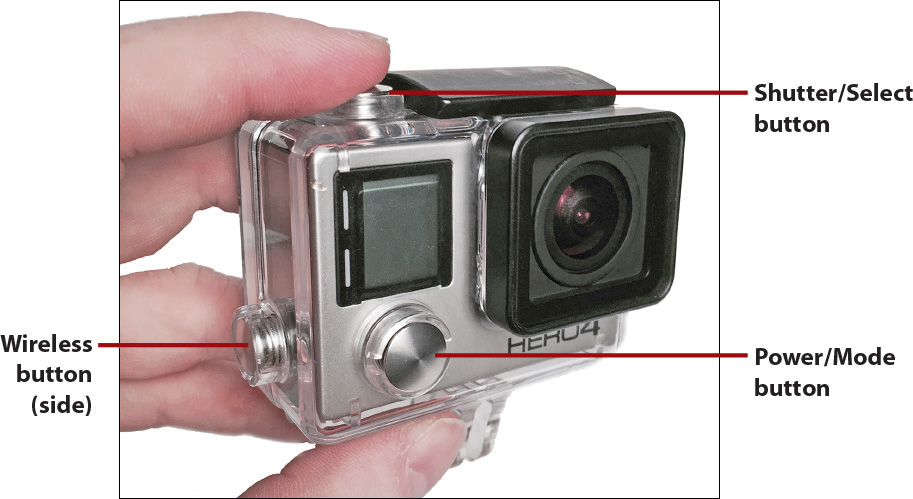
Remove the Camera
To remove the camera from a housing, follow these steps:
1. Unlock the latch on the top of the housing by lifting up the front of the latch.
2. Unhook the rear section of the top latch from the housing.

3. Separate the front and backdoor by moving them apart, keeping in mind that the front and backdoors are attached via the hinge at the bottom.
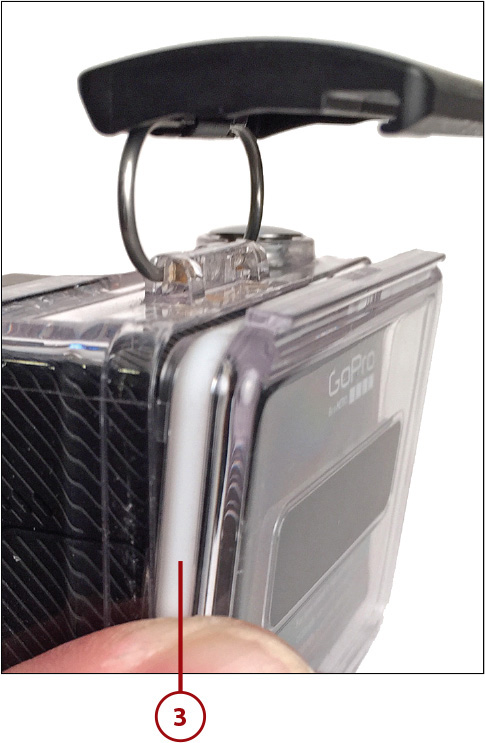
4. Remove the camera from the housing.
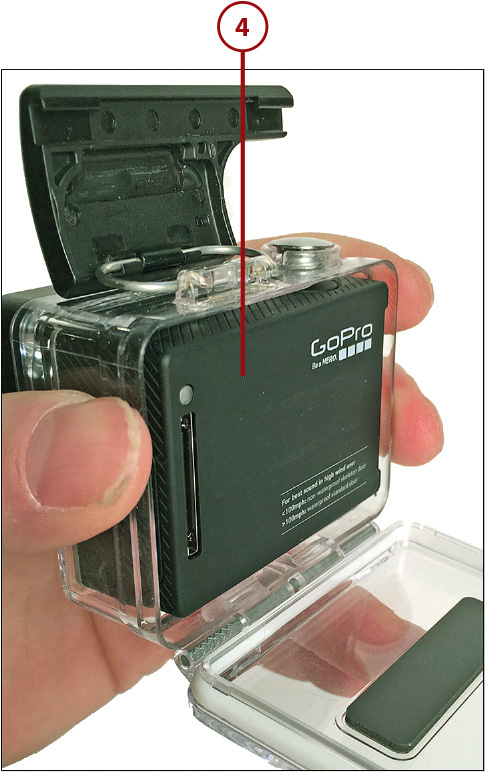
Protect the Housing’s Latch Mechanism
When a housing is not in use, it’s a good idea to keep the top latch closed to prevent the latch mechanism from accidentally bending or breaking.
1. Attach the proper backdoor to the housing using the information provided within the section of this chapter titled, “Using the Appropriate Backdoor for a Housing.”
2. The front and backdoor of the housing should connect together via the hinge at the bottom of the housing. The top latch, however, should be unlocked.
3. Check the camera and its lens to make sure it’s clean. Also check to ensure a memory card is installed within the camera and that the battery within the camera is fully charged.
4. Check the housing to make sure it is clean and that there’s no water or dirt inside it. Make sure that the area in which the lens will go within the housing is clean on the inside and outside.
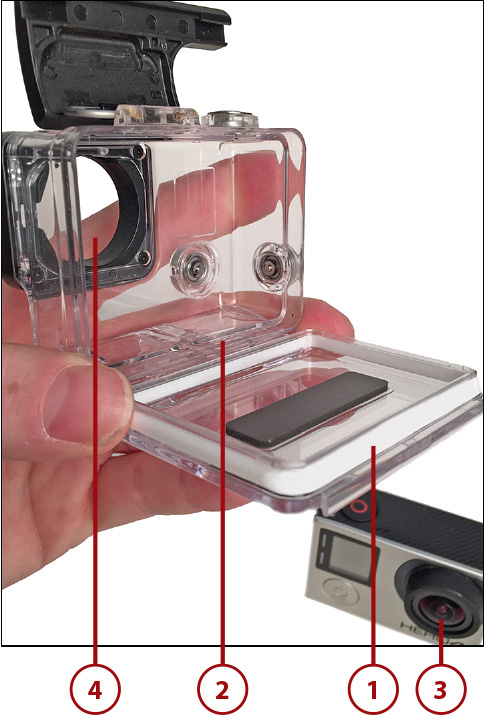
5. Carefully insert the camera into the front of the housing. It should line up perfectly.
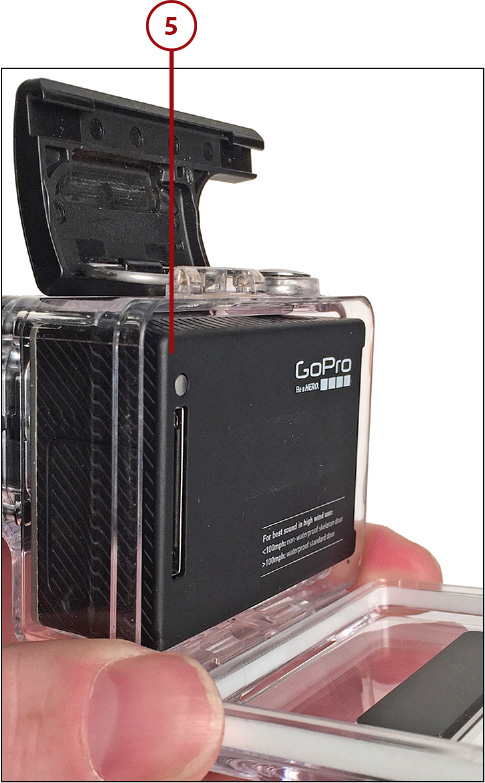
Snug Fit
When inserting your camera into a housing, the fit should be perfect, and in most cases, the camera should wind up fully encased and well protected. When inserting the camera into a housing, the housing can remain connected to a mount, or you can attach an optional mount to the housing later.
6. Close the backdoor, making sure the rubber seal is intact.
7. Connect the rear portion of the top latch that’s connected to the front door to the appropriate hinge on the backdoor.
8. Press the front and backdoor together with your fingers, and then press down on the top latch to lock it into place. The camera is now encased and protected within its housing. It’s now safe to expose the camera to water, dirt, and other harsh conditions, assuming you’re using an appropriate waterproof housing.

Keeping Your Housing Clean
Although the proper housing protects your GoPro camera from water, if water drops land on the housing and remain over the camera’s lens while you’re shooting, your photos or videos can easily get ruined. The same is true for dirt or dust.
To wipe the lens, always use a microfiber lens cleaning cloth—not your finger, shirt sleeve, tissue, or paper towel.
It’s a good strategy carry a microfiber lens cleaning cloth with you at all times when shooting, so if you notice water drops or dirt covering the lens (or the housing), you can quickly wipe it clean.
A Micro Fiber Lens Cleaning Cloth Is a Low-Cost Investment
You can purchase a microfiber lens cleaning cloth from anyplace that sells cameras, eyeglasses, or sunglasses, as well as most pharmacies. They typically cost between $5.00 and $8.00.
Using a microfiber lens cleaning cloth is even more important if you wind up needing to directly wipe off or clean the camera’s lens. The glass that comprises your camera’s lens is delicate and can easily get scratched if you use anything but a proper lens cleaning cloth.
Especially after the camera (while within the housing) has been exposed to dirt or salt water, you need to rinse off the housing using fresh water and then dry the housing with a lens cleaning cloth.
When rinsing the camera, pay careful attention to the rubber seal on the housing’s backdoor. This seal must be kept clean, but you should avoid touching it with your fingers or lens cleaning cloth. Allow this area of the housing to air dry. This is important for maintaining the integrity of the watertight seal that the housing provides.
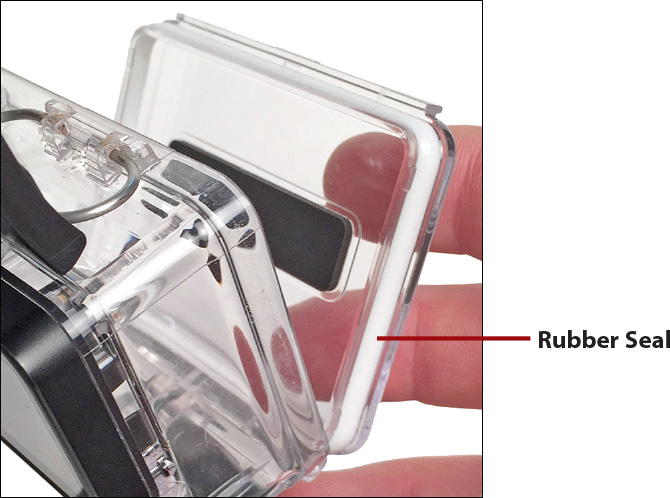
If this rubber seal becomes compromised with a hair, speck of dirt, or corrosion from salt water, it could allow the housing to leak, causing your camera to get damaged. If you notice this rubber seal weakening or cracking over time, or if it gets too dirty and can’t be cleaned, replace the backdoor altogether.
There is never a need to use harsh cleaning solutions (including glass cleaner) when cleaning the camera or its housing.
Using the Appropriate Backdoor for a Housing
Choosing the appropriate backdoor for your selected housing is as important as choosing the proper housing for your shooting situation. There are two main considerations when selecting a housing backdoor:
• The width of the backdoor (which determines whether the housing can accommodate an accessory)
• The design of the backdoor (which determines whether it offers waterproof protection)
This Standard Backdoor offers a watertight seal for the camera but offers no direct access to the camera’s ports, battery compartment, or memory card slot. There are several Standard Backdoor variations, so the one you’re using may look slightly different. Make sure it is a waterproof Standard Backdoor, however, if you’ll be using the camera in or around water.
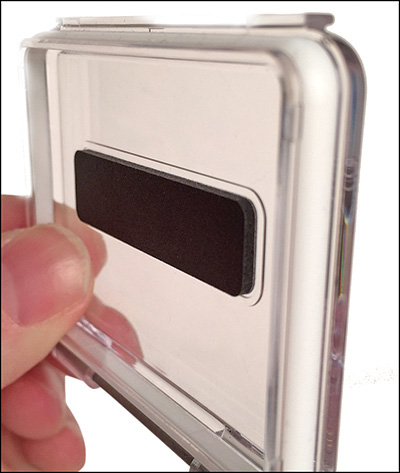
Each housing comes with a backdoor that perfectly fits the GoPro camera when no accessories are connected to the camera. The Standard Housing Backdoor is constructed from solid (clear) plastic and helps to create a watertight seal with the front door of the housing.
When the camera is encased within one of these standard housings (utilizing a Standard Backdoor), you have no direct access to the camera, but it is fully protected and waterproof (to a depth of 131 feet).
If you use your GoPro camera with the LCD Touch BacPac or Battery BacPac, either of these accessories increases the thickness of the camera. Thus, you need to replace the backdoor of your housing with one that can accommodate this extra thickness.
Some Accessories Come with Specialty Housing Backdoors
When you purchase the LCD Touch BacPac or Battery BacPac accessory (sold separately) each comes with several thicker backdoors in a variety of configurations. You need to detach the existing backdoor from your housing and then attach one of these thicker backdoors, which are also sold separately.
In addition to a Standard Housing Backdoor, there are two other types of backdoors that can be attached and used with most housings.
Instead of a solid plastic backdoor, GoPro offers a Touch BacPac Backdoor. This is constructed of a softer plastic. Thus, if you use the LCD Touch BacPac with the camera, using a Touch BacPac Backdoor enables you to use the touch screen while the camera is encased within a housing. This does, however, impact the level of protection that’s offered. For example, using this backdoor with your camera waterproofs it to a depth of only10 feet.
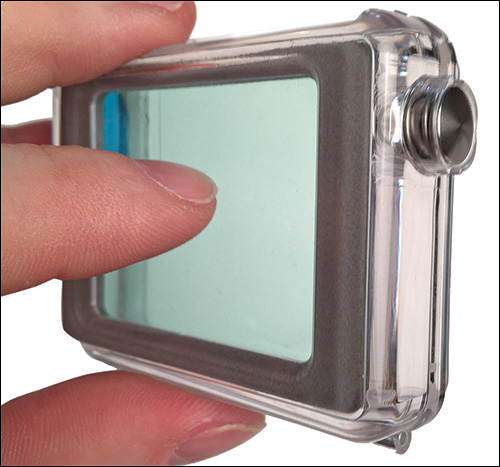
The GoPro Hero4 is shown here encased in a Standard Housing with a Skeleton Backdoor. Because the camera is not fully sealed within the housing, the camera’s built-in microphone can capture better quality sound when you shoot video, and you can access the LCD Touch BacPac display.
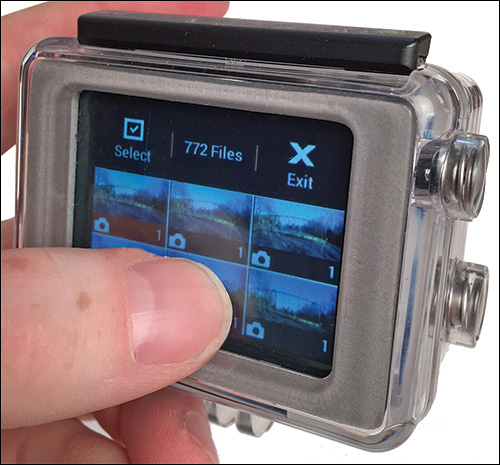
However, because it’s wide open, this backdoor offers no waterproof protection whatsoever. It also doesn’t grant you access to the camera’s ports. For this access, you need to use the optional Skelton Housing, not the Standard Housing with a Skeleton Backdoor attached.
1. Hold the housing upright in your hands.
2. Remove the camera and any mount that’s attached to the housing.
3. Open the backdoor so that the backdoor points slightly downward. Gently pull straight down on the backdoor until it snaps apart from the front door.

4. Select the backdoor you now want to attach (not pictured).
5. While keeping the backdoor at an angle, line up the hinge on the front door with the metal bar related to the hinge on the backdoor.
6. Push upward on the backdoor until the hinge clicks and locks into position.

7. Without inserting the camera, try closing the housing to make sure the seal is tight after you close the top latch (not pictured). If it is, insert the camera and close the housing.
No Tools Needed
The backdoor you opt to use with the camera’s housing depends on what equipment you plan to use with your camera, as well as the shooting situation. Replacing the backdoor of a housing is easy, and no tools are required. The trick is to be gentle so that you don’t accidentally break the plastic hinge of the housing.
Discovering Your Housing Options
Now that you understand that a variety of different housing options are available, and you can use each housing with one of several different backdoors, take a closer look at various housings, and focus more on what each is used for. It’s never a good idea to use your GoPro camera without some type of housing.
Choose the Right Housing for Your Camera Model
Because the design of the camera body varies slightly by camera model, some of the housings are offered in a version compatible with just the Hero, Hero3/Hero3+, and Hero4 camera models. Be sure to purchase housings that are designed specifically for your camera model.
Standard Housing
The Standard Housing with a Standard Backdoor attached is shown here with the GoPro Hero4 camera.
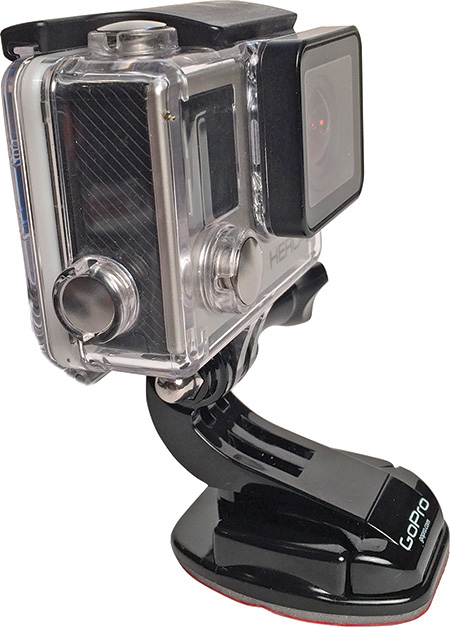
This is the housing that came bundled with your camera. It’s the most versatile, and when in use with a Standard Backdoor, it fully encases your camera to offer watertight protection to a depth of 131 feet.
Use this case when you film in or around water and in harsh climates, and to prevent your camera from being directly exposed to dirt or dust.
You can purchase a replacement GoPro Standard Housing for $49.99 from the GoPro website (or any GoPro dealer). If you plan to use the optional LCD Touch BacPac display or Battery BacPac with your camera, you need to acquire a separate and thicker Standard, Skeleton, or Touch BacPac Backdoor to use with this housing.
Table 3.1 can help you select the most appropriate backdoor when using the Standard Housing, based on your shooting situation.
Skeleton Housing
The Skeleton Housing gives you access to the camera’s ports while the camera is in use.
Not to be confused with the Skelton Backdoor that you can use with the Standard or Dive Housing, the Skeleton Housing ($49.99) can help to protect the camera from physical damage, while granting you full access to the camera’s ports and built-in microphone when the camera is in use.
This housing offers no waterproof protection whatsoever. Use this housing in calm shooting situations, when you want to capture better audio quality using the camera’s built in microphone, or you’d like to connect an external microphone to the camera and need access to the mini-USB port.
Parents who want to shoot video of their child engaged in an outdoor sport (assuming it’s not raining) can benefit from using this housing to protect the camera but record good quality sound. It’s also a good choice to mount inside of a vehicle or when shooting indoors, for example.
Table 3.2 can help you select the most appropriate backdoor when using the Skeleton Housing, based on your shooting situation.
Dive Housing
GoPro’s optional Dive Housing ($59.99) is the most durable housing offered. It’s designed for use when scuba diving or when shooting in extreme conditions. The front of this housing is designed specifically to offer the best image sharpness possible, whether you shoot above or below the water.
If you shoot in or near water—at a beach, swimming pool, or on a boat, or use the camera while snorkeling, surfing, or kayaking—this is the best housing to use. (Although, the Standard Housing with a Standard Backdoor can also provide ample waterproof protection.)
You Wear Scuba Gear When Scuba Diving, So Should Your Camera
The Dive Housing when used with an optional colored lens filter and the Anti-Fog inserts is best suited for scuba diving. This housing makes the camera fully waterproof to a depth of 197 feet. The Dive Housing is constructed from thicker plastic and a more durable rubber waterproof seal.
Table 3.3 can help you select the most appropriate backdoor when using the Dive Housing, based on your shooting situation.
Blackout Housing
The Blackout Housing functions exactly like a Standard Housing, but instead of being constructed from clear plastic, this housing encloses your camera within a black shell that makes it more difficult to see, especially in low light situations.
There may be times when you want to take photos or videos but remain incognito or undercover. As its name suggests, the Blackout Housing ($49.99) fully encases the camera within a protective, matte black finished housing, which gives it a low profile. This housing offers waterproof protection to a depth of 131 feet, but its main purpose is to encase the camera within a nonreflective housing that offers low visibility.
This housing comes with a Standard, Skeleton, and Touch Backdoor that is also black. When you use this housing, the operation of the camera’s lens and Status Screen is unhindered, but the rest of the housing, including the buttons, are black. It’s also possible to use the supplied concealment stickers to block glare and reflection caused by the Status Screen and LCD Touch BacPac screen (if it’s attached to your camera).
The Frame Housing
The Frame Housing offers minimal protection to the camera but grants you access to its ports, as well as allowing you to connect a mount to the camera.
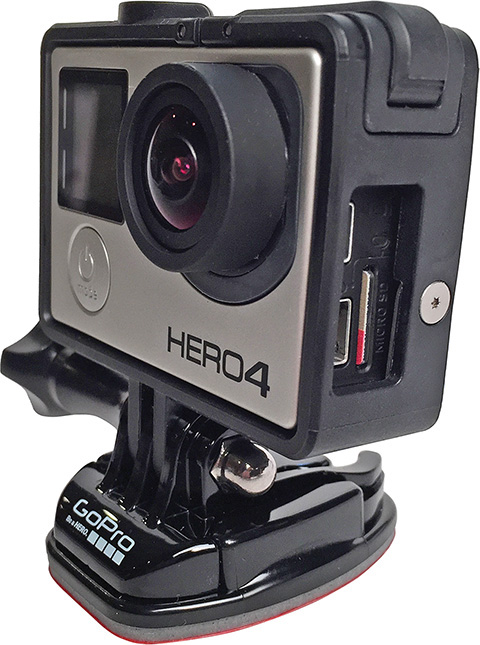
The Frame Housing ($39.99) is the least cumbersome housing option available. You should use it only in calm, dry, and clean shooting environments, to allow you to use a mount with the camera without fully encasing it within a housing.
Protect Your Camera’s Lens When It’s Not Enclosed in a Housing
If you opt to use the Frame Housing outdoors, consider attaching the supplied lens protector to the camera’s lens to help keep it clean and prevent it from getting accidentally scratched or cracked.
When using the Frame Housing, you can capture the best quality audio using the built-in microphone, or you can attach an external microphone (sold separately) to the camera when you use GoPro’s optional 3.5mm Mic Adapter ($19.99).
Using the supplied extendable support arm, the Frame Housing can accommodate the GoPro camera with either the LCD Touch BacPac or Battery BacPac attached to it. If neither of these accessories are used with the Frame Housing, be sure to insert the supplied Hero Port cap over the unused Hero Port to keep it clean.
Musicians, for example, often use the Frame Housing with a mount that allows them to attach the GoPro camera directly to their instrument, music stand, or microphone stand. Because the camera’s lens and microphone are in no way hindered by a more elaborate housing, you can shoot clearer photos or videos with better quality sound.
Parents who want to take photos or videos of their child performing in a show, concert, or indoor dance recital, for example, typically can achieve the best results using this Frame Housing with their camera, with a traditional tripod to hold the camera still while shooting.
Frame Housing Redesign
Since first introducing this Frame Housing, GoPro has redesigned it to include an integrated latch and one-piece design. This new design makes it faster and easier to insert or remove the camera from this housing, even when the frame is attached to a mount.
Dual Hero System Housing
Designed mainly for serious videographers, this Dual Hero System Housing ($199.99) is designed to securely hold two separate GoPro cameras in place. Using this tandem method of shooting, you can create 3-D photos or video footage using the GoPro Studio software. This housing is fully waterproof (to a depth of 197 feet). At the time this book was written, only the GoPro Hero3+ Black Edition cameras could be accommodated by this housing. A version for the Hero4 was not yet released.
Third-Party Camera Housings
If you use any popular Internet search engine with the search phrase, “GoPro Camera Housings,” you can discover many third-party companies that offer compatible housings designed for specific GoPro camera models.
The housing you use is designed to offer protection to your camera, which represents a several hundred dollar investment on your part. Thus, if you opt to use your camera with a housing that’s designed and manufactured by a company other than GoPro, make sure it offers equivalent quality in its design, construction, and durability.
The construction quality of the housing’s Quick Release Buckle and Thumb Screw are also important for keeping your camera securely in place when shooting. It’s often a good strategy to use only a genuine GoPro housing with your camera.
However, there are literally hundreds of third-party camera mounts and accessories that are extremely well made and that can greatly expand the versatility of your camera’s capabilities, plus save you money. These mounts are fully compatible with the popular GoPro camera housings. You’ll learn more about some of these products in the next chapter.
